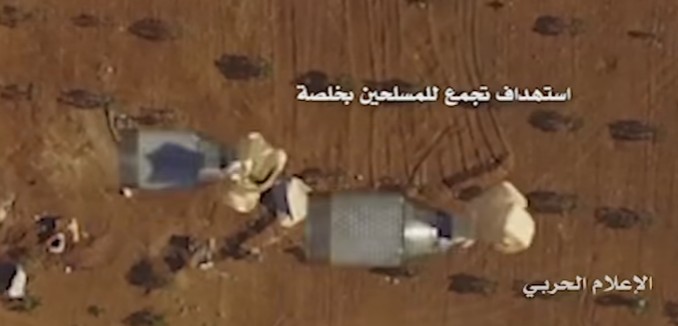A video reportedly showing a drone operated by Hezbollah attacking a number of targets near Aleppo was released by a media source close to the terrorist group on Tuesday.
Three separate attacks are seen in the video: the first is described as targeting “a [rebel] leader’s base,” the second is against a pickup truck allegedly belonging to unidentified “gunmen,” and the third hits “a gathering of gunmen.”
The bombs appear to be Chinese-made MZD-2 submunitions, alternatively known as Type-90’s, Beirut-based NOW News reported. These armor-piercing explosives are typically encased in cylinders packed with steel ball bearings and then placed inside Chinese-made Type-81 122mm rockets in order to create cluster munitions. Hezbollah deployed these munitions against Israel in 2006, according to Human Rights Watch.
Hezbollah is first known to have used a drone in October 2012, when one breached Israeli airspace from the Mediterranean Sea and flew 55 kilometers (about 34 miles) before being shot down over the Negev desert. Hezbollah leader Sheikh Hassan Nasrallah claimed that the drone, which he said was made in Iran but assembled in Lebanon, was part of a spying mission.
While past videos from Hezbollah’s drones have featured reconnaissance footage, the clip released Tuesday appears to be the first showing the group’s potential offensive capabilities. It also was the first from Syria’s Aleppo region.
Hezbollah’s disregard for international law and its tactic of embedding military infrastructure in residential areas led Stéphane Cohen, head of diplomatic outreach and security analysis for The Israel Project (which publishes The Tower), to predict last week that the next war between Israel and Hezbollah “will be catastrophic.”
A report published by the Foundation for Defense of Democracies (FDD) last month noted that Israeli officials believe that the next war with Hezbollah — which has threatened to strike at Haifa, Tel Aviv, and other sites in Israel — has the potential cause “thousands of civilian deaths” in Israel. (This past February, Nasrallah threatened to attack ammonium tanks in Haifa, which could kill tens of thousands of people.)
Jonathan Schanzer, vice president of research for FDD, explained that Hezbollah’s widely-reported tactic of hiding military assets in civilian areas may also lead to mass casualties. Reports emerged two years ago that Hezbollah was offering reduced-price housing to Shiite families who allowed the terrorist group to store rocket launchers in their homes. An Israeli defense official told The New York Times in May 2015 that the buildup of Hezbollah’s terror infrastructure in southern Lebanese villages meant that “civilians are living in a military compound” and that their lives were at risk. A few days later, a newspaper linked to Hezbollah confirmed the Israeli assessment.
Sheikh Hassan Nasrallah, chief of Hezbollah, boasted in June that all of “its weapons and rockets” come from Iran. Nasrallah’s speech seems to confirm an assurance given to him last August by Iranian Foreign Minister Mohammad Javad Zarif that the nuclear deal presented “a historic opportunity” to confront Israel. Iran recently announced that its military spending would increase by 90% in the coming year.
Nasrallah’s comments also call into question assurances made by Secretary of State John Kerry that the U.S. would ensure that Iran could not arm Hezbollah, despite the lifting of nuclear sanctions against Tehran. “Our primary embargo is still in place,” Kerry said at a Senate hearing last year. “We are still sanctioning them. And, I might add, for those things that we may want to deal with because of their behavior, for instance, Hezbollah, there is a UN resolution, 1701, the prevents the transfer of any weapons to Hezbollah. That will continue and what we need to do is make sure that we’re enforcing it.”
While UN Security Council Resolution 1701, which was passed unanimously to end the 2006 war, forbids the arming of Hezbollah, Iran has continued to send the terrorist group weapons and the Security Council has refused to act to enforce the resolution.
[Photo: الاعلام الحربي المركزي / YouTube ]




